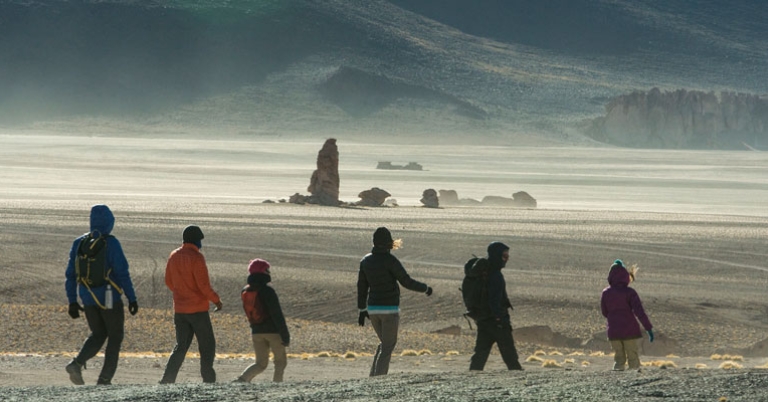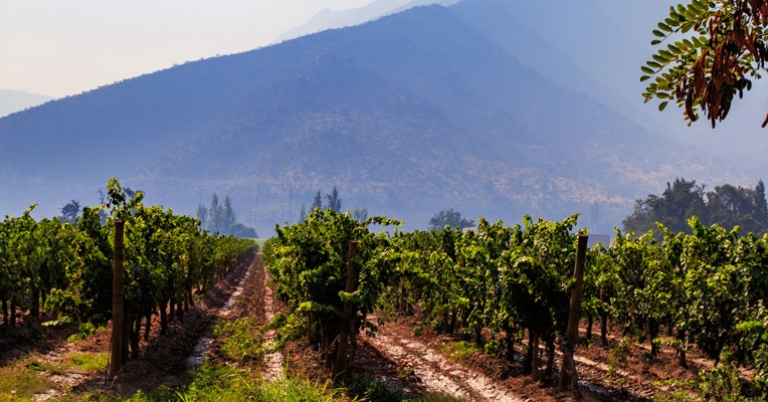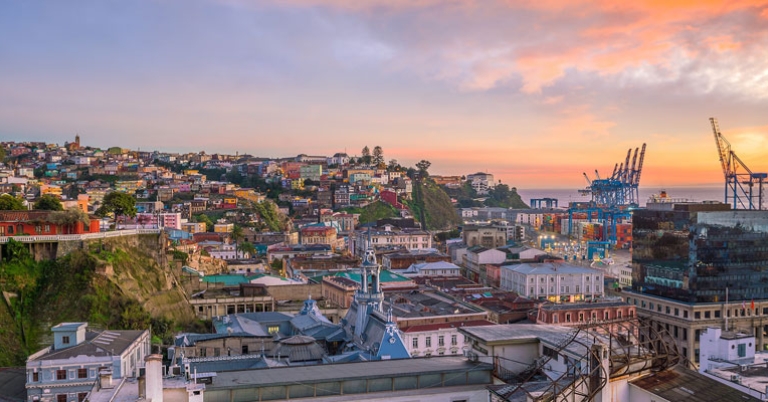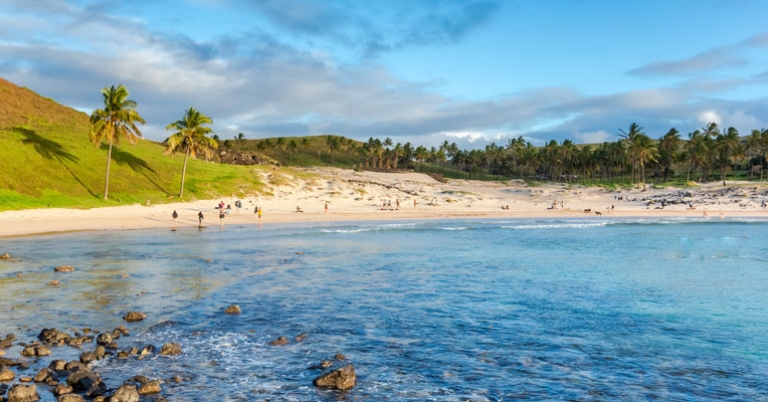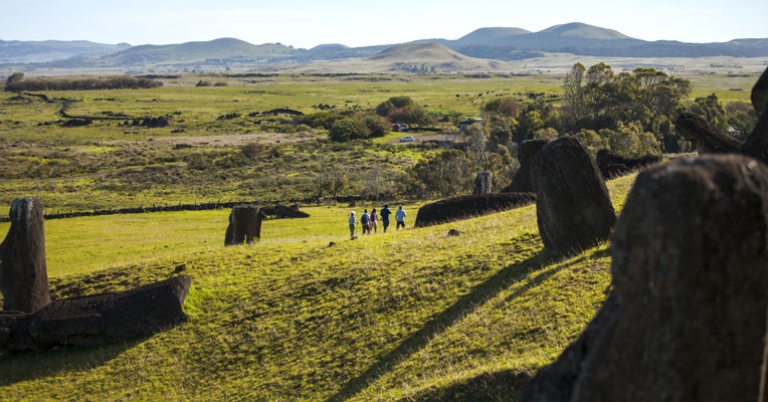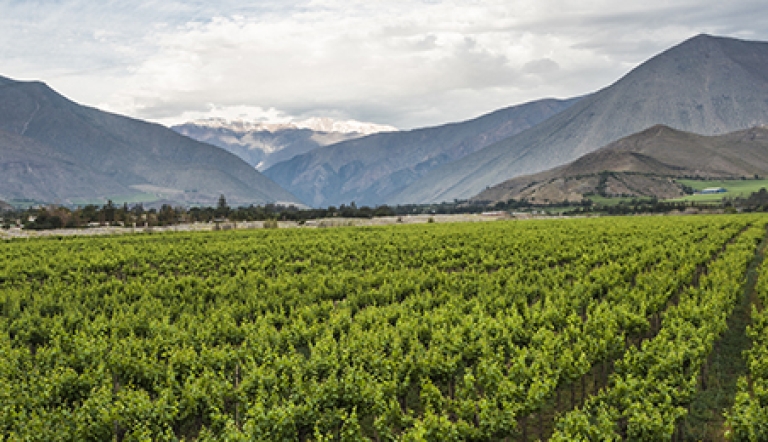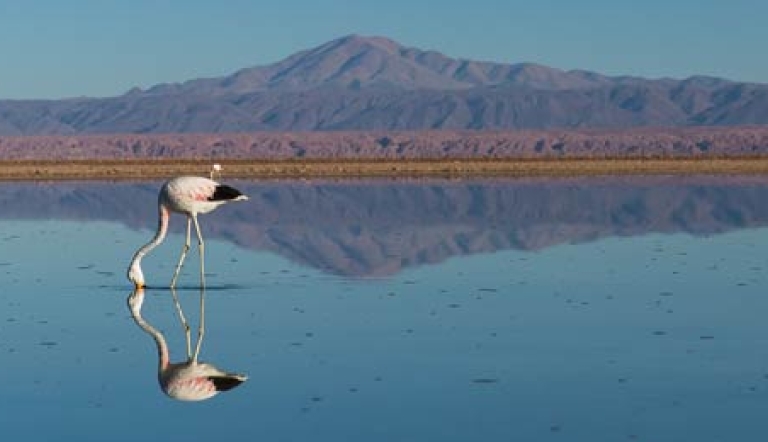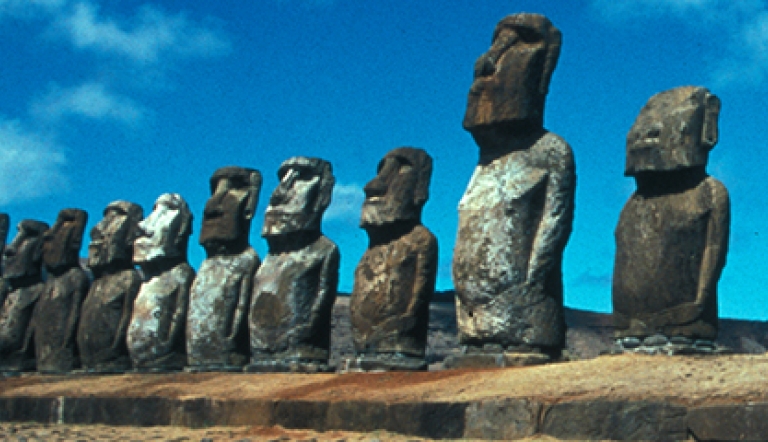Chile | The Wonders of Chile: from Atacama to Rapa Nui with Duquesne Alumni and Friends
About this trip
 Explore spectacular natural beauty and rich cultural heritage on this exciting adventure to some of Chile's most iconic locations. Join Duquesne Alumni and Friends on an unforgettable 13-day journey that begins in Santiago, Chile’s colorful, historic capital and cultural center, and its surrounding wine regions. From there, continue to the vibrant artistic scene of coastal Valparaíso, the dramatic stone and sand formations of Chile’s Atacama Desert, and the beautiful island of Rapa Nui, known for its mysterious and imposing Moai statues. Marvel at the dramatic contrasts of this sprawling country and learn about the history behind Chile’s rich culture at every one of these striking sites.
Explore spectacular natural beauty and rich cultural heritage on this exciting adventure to some of Chile's most iconic locations. Join Duquesne Alumni and Friends on an unforgettable 13-day journey that begins in Santiago, Chile’s colorful, historic capital and cultural center, and its surrounding wine regions. From there, continue to the vibrant artistic scene of coastal Valparaíso, the dramatic stone and sand formations of Chile’s Atacama Desert, and the beautiful island of Rapa Nui, known for its mysterious and imposing Moai statues. Marvel at the dramatic contrasts of this sprawling country and learn about the history behind Chile’s rich culture at every one of these striking sites.
Highlights
- Embark on a once-in-a-lifetime trip that encompasses rich cultural experiences, beautiful scenery, extraordinary and unique accommodations, and the chance to bond over all these wonderful moments with fellow travelers.
- Marvel at some of the most breathtaking scenery in the world as we visit the driest desert in the world, the Atacama. The moon-like landscape features turquoise lagoons, geysers, and clear night skies for stargazing at night. Additionally, visit Rapa Nui (Easter Island), which is well-known for its Polynesian culture and archaeological marvels, including the enormous and mysterious Moai statues. There are also volcanic craters, beaches, and sweeping views of the Pacific Ocean.
- Enjoy the most exquisite accommodations on this trip, which include the Tierra Atacama and the Explora Rapa Nui. Both are 5-star boutique properties with an emphasis on capturing and enhancing the beauty of their natural surroundings with eco-friendly architectural design. Their outstanding concierge services allow you to customize your activities in these locations, so everyone can have a unique experience based on interests and activity level.
- Experience one of the most exciting parts of this adventure: the Tapati Rapa Nui, which is the premiere cultural festival on the island of Rapa Nui. This celebration happens every February and showcases the music, dance, colors, costumes, and traditions of the island inhabitants. During the day, there are sporting competitions throughout the island, and during the evenings, everything comes alive with exuberant celebrations. We will be able to take advantage of this amazing energy during our four days on the island.
- Take in the sights and sounds of Chile’s vibrant capital of Santiago, visit the coastal city of Valparaíso, a UNESCO World Heritage Site, and learn about its history and community from a local artist, and sample Chilean wine at two of most important wine-producing regions of Chile, the Maipo and Aconcagua Valleys.
$13,915
Per person
About this price
Land cost only. Does not include round-trip airfare to and from destination.
Single room supplement $6200
$300 Early Bird Discount!
Promo code: DUQUESNE
For participants who deposit by August 1, 2023,
and are fully paid by the final payment deadline,
there will be a $300 discount in the land cost.
What makes us different
Rich content
Carbon offsetting
Service anytime
Culture in context
Support local communities
Flight arrangements
Daily Itinerary
Print ItineraryIn Flight
Santiago
Santiago
Atacama
Atacama
Atacama
Maipo Valley
Rapa Nui
Rapa Nui
Rapa Nui
Santiago
Depart
In Flight
Pricing
Print Pricing$13,915
Per person
About this price
Land cost only. Does not include round-trip airfare to and from destination.
Single room supplement $6200
$300 Early Bird Discount!
Promo code: DUQUESNE
For participants who deposit by August 1, 2023,
and are fully paid by the final payment deadline,
there will be a $300 discount in the land cost.
What's Included
- Activities and meals as mentioned in itinerary
- All tips
- Bottled water or water refill station during transfers
- Carbon Offset
- Full time guide per region for the duration of your program
- Internal flights relevant to itinerary
- Non alcoholic beverage with meals
- Private transportation for tours and transfers
What's Not Included
- International airfare
- Travel Insurance
Pricing Details
A $1000 per person deposit and enrollment form is due to hold your space on this trip. This deposit is refundable 125 days prior to departure excluding a $300 cancellation fee. Cancellations after this date are non refundable.
Holbrook Travel strongly recommends the purchase of travel protection for medical emergencies while traveling and to protect your investment. Please note the purchase of Cancel for Any Reason Coverage or to exclude pre-existing conditions with Trip Cancellation coverage may require policy purchase within 10-14 days of your initial deposit, depending upon the provider.
Single room supplement $6200
Final payment due date: October 03, 2023
Travel Info
Print Travel InfoEntry & Exit Requirements
U.S. and Canadian citizens must have a valid passport to enter Chile. Passports must be valid for at least six months after the date of entry.
A visa is not required for visits up to 90 days.
A tourist card is required for anyone entering Chile from the United States and is issued upon arrival. This card allows visitors to stay for up to 90 days and will allow multiple entries. Keep the tourist card with your passport; it is important not to lose it, as you must present the card to Customs when you leave the country.
If you are not traveling with a U.S. passport, please check with the Chilean Embassy for the requirements based on your nationality.
Health Information
IMMUNIZATIONS
The Centers for Disease Control recommends that all travelers be up to date on routine vaccinations such as measles-mumps-rubella (MMR) vaccine, diphtheria-pertussis-tetanus vaccine, varicella (chicken pox) vaccine, and your yearly flu shot before every trip.
There are no vaccinations required for entry into Chile.
The CDC recommends inoculation against hepatitis A, hepatitis B, and typhoid for most unvaccinated travelers to Chile.
Please consult your physician for additional information and recommendations based on your individual circumstances.
ALTITUDE SICKNESS
Upon arrival at locations of high elevation, shortness of breath and a pounding heart are normal responses to the lack of oxygen in the air. However, for some visitors, these symptoms can deteriorate into altitude sickness. Headache, extreme tiredness, dizziness, nausea, and loss of appetite are standard symptoms. Staying hydrated and well rested is important to adjust to the altitude. Avoiding heavy, fatty foods and alcohol in the days before arriving to altitude can help. Over-the-counter medications are also available to help prevent or alleviate symptoms. It’s advisable to avoid sleep medications, as they can slow breathing and respiration, which aid in getting the blood oxygenated while sleeping. Participants who take blood pressure medications should discuss this with their doctor as the medication can drop pressure too low at times.
SUN EXPOSURE
The effects of the sun can be damaging to the eyes and skin. Spending time outdoors exposes you to the sun’s harmful ultraviolet (UV) rays, even on cloudy days. To protect yourself from the sun, use a broad spectrum sunscreen of at least SPF 15, protect skin with clothing, wear a wide-brimmed hat and sunglasses, and drink plenty of fluids.
Resources
Print ResourcesSuggested Packing List
Everyone has personal preferences when it comes to packing; for this reason, the information below is offered as a general guide and not a definitive list. You know yourself best: Use your discretion and pack what you think will serve you, based on your personal preferences and specific itinerary.
You may find many of the items below in our Gear Store.
CLOTHING
Casual, comfortable clothing is suitable for most activities. You may wish to bring a slightly nicer outfit or two if your itinerary includes dinners out or more formal activities. Keep in mind that locals tend to dress conservatively.
Bring enough clothing suitable for the length of your program. If you prefer to pack light, note that many hotels offer laundry services at an additional cost.
Pack clothing that can be worn in layers to adapt to weather changes throughout the day. Santiago experiences a mild, Mediterranean climate, with average highs in the 80s during the summer months (Dec-Feb) and in the 60s during the winter (Jun-Aug). Easter Island (Rapa Nui) is subtropical and can be warm and humid in the summer, while winters are typically mild.
- Shirts: Several short- and long-sleeved shirts that can be worn in layers
- Shorts/skirts
- Lightweight to medium-weight long pants, slacks, or jeans
- Undergarments and socks
- Sleepwear
- Jacket, fleece, or sweater/sweatshirt
- Hat or sun visor
- Bathing suit: Pools are available at some hotels.
- Shoes: Consider your specific itinerary when choosing footwear. For most programs, you’ll likely want at least one pair of comfortable, closed-toe walking or hiking shoes suitable for outdoor hikes and walking over cobblestones or other uneven terrain. Sturdier hiking boots may be appropriate for more rugged itineraries. In addition, many participants opt for a pair of sturdy sport-strap sandals (e.g. Keens, Tevas, or similar) and/or casual flip-flops or sandals.
- Lightweight rain jacket, hooded poncho, and/or windbreaker
- Bandana, scarf, or Buff-style headwear
Personal Toiletries
Pack toiletries based on your personal preferences and habits. Below are just a few recommendations to keep in mind.
- Shampoo, conditioner, lotion, deodorant/antiperspirant , etc. – If possible, avoid strong fragrances if you are sensitive to insect bites.
- Soap and washcloth or a small, quick-drying microfiber towel – Washcloths are not standard in all hotels. If you normally use a washcloth, you may wish to bring one from home.
- Hairbrush, comb, hair ties, shower cap. Most—but not all—hotel rooms provide a hair dryer, but you may wish to bring one from home.
- Toothbrush and toothpaste
- Razor
- Ear plugs, especially if you are a light sleeper
- Personal hygiene products
- Insect repellent with DEET or picaridin
- Sunscreen and lip balm with SPF – If you’ll be in the ocean, we recommend reef-safe sunscreen.
- Aloe vera gel
- A travel pack of tissues – also useful as napkins or toilet paper if needed
In addition to your personal toiletries, it is useful to pack a small medical kit, which you can easily prepare. Helpful items might include: bandages, antihistamine, a pain reliever, motion sickness and/or altitude sickness medication (if you are prone to either), anti-diarrhea medicine, individually wrapped pre-moistened towelettes and/or hand sanitizer, antibiotic ointment, anti-fungal cream, moleskin for blisters, eye drops, tweezers, a mini sewing kit, and an extra pair of disposable contact lenses or eyeglasses if you wear them.
Miscellaneous
Remember to pack valuables such as your passport, cash/credit cards, and medications in your carry-on luggage.
- Passport and photocopies of all travel documentation
- Personal insurance card and travel insurance information
- Money – ATM/credit card, traveler's checks, and/or cash; small bills in good condition are recommended
- Prescription medicines (if applicable), with a copy of the prescription
- Yellow fever certificate (if required; only if arriving from a country where yellow fever transmission is a risk
- Sunglasses with strap
- Small day pack for hikes and excursions
- Flashlight and/or head lamp
- Travel alarm clock or inexpensive waterproof wristwatch with alarm – Not all hotels provide alarm clocks.
- A pocket calculator or phone to assist with conversions and currency exchange
- Binoculars with lens cleaner
- Camera and related equipment, such as charger, lenses, and extra memory cards
- Reusable water bottle
- Non-perishable snacks
- Pocket-knife or multipurpose tool - Pack in your checked luggage
- Zip-top style bags – useful for packing toiletries, sorting clothing, storing damp or muddy shoes, or as a dry bag for protecting electronics)
- Notepad or travel journal and pen
- Music or reading material for down time, long bus drives, or on the airplane, and a portable bright light to read by
- Collapsible walking stick with rubber tip
- A small quantity of laundry detergent if you’ll be washing clothing by hand
- Travel-size umbrella – Some people find this unwieldy to carry, while others find it offers better protection than a rain jacket alone.
- Money belt
- Plug adapter and voltage converter for electronics
- Chargers for electronics

Questions
For more information, contact Kevin Van Dien at kevin@holbrooktravel.com or 800-451-7111 x312


